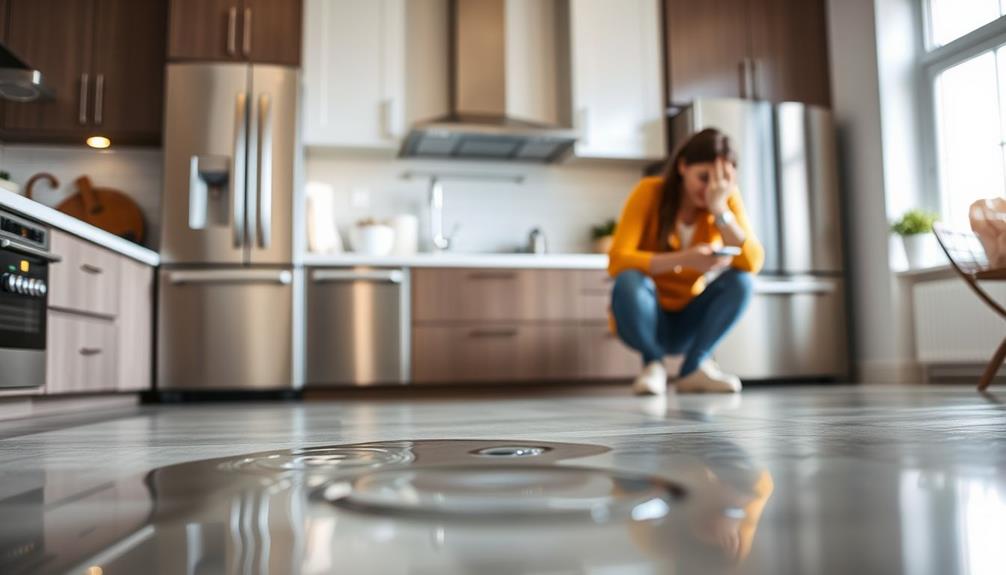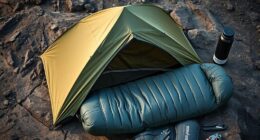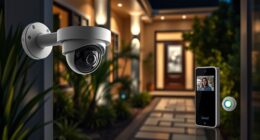To turn your home into a fortress, start by evaluating your security risks and fortifying entry points. Install high-quality locks and security cameras, and use motion-sensor lights to illuminate dark areas. Keep your windows secure with locks and consider adding glass break sensors. Minimize visibility by trimming shrubs and closing blinds, making it harder for intruders to gauge your presence. Don't forget to prepare an emergency kit and establish communication plans. Implement these strategies to guarantee safety and comfort, and you'll discover even more valuable tips to enhance your home's security.
Key Takeaways
- Install high-quality deadbolt locks, smart locks, and security cameras on all entry points to deter intruders effectively.
- Enhance outdoor security with motion-sensor lights, maintaining well-lit entrances and trimming landscaping to eliminate hiding spots.
- Conduct regular home security assessments to identify vulnerabilities and implement necessary upgrades, such as window locks and glass break sensors.
- Create an emergency preparedness plan, including essential supplies and secure areas within the home for safety during crises.
- Manage utilities by turning off power, water, and gas during evacuations, and regularly inspect wiring and gas lines for safety.
Assessing Home Risks

Evaluating your home's risks starts with a thorough evaluation of its exterior perimeter. Begin by examining how visible your home is from the road and by passersby. A well-lit and visible property can deter potential offenders. Make certain your house numbers are clearly marked for easy identification by emergency services. Next, trim any trees and shrubs that might conceal doors or windows, as this can provide cover for intruders.
Consider installing sensor lighting in high-risk areas to alert you to any movement outside during the night. Review your perimeter fencing, landscaping, and signage to verify they effectively contribute to your home's security. Pay attention to any potential vulnerabilities that could be exploited, as regular home security assessments can help identify and address these weaknesses.
Securing Entry Points

Securing Entry Points
After evaluating your home's risks, it's time to focus on securing the entry points. Start with the front door, as 34% of burglars enter this way, often due to it being open. Install high-quality deadbolt locks with a 1-inch throw and reinforced strike plates. Consider smart locks and security cameras to deter intruders. Regularly check that all door locks function properly, and change locks when moving into a new home. Make sure your doorframes are secure by avoiding gaps and using solid wood or steel doors. Additionally, keep in mind that up to 30% of burglaries occur through unlocked doors or windows, emphasizing the need for vigilance. Investing in a home security system can further enhance your protection, especially those that integrate with smart home devices for added convenience. Additionally, incorporating high-quality air purifiers can help improve indoor air quality, creating a healthier environment for your family.
Next, secure your garage. Since 9% of burglars enter through this entry, use remote operation systems and motion-detection lights. Lock any doors connecting the garage to your home with deadbolts and maintain your garage doors to deter break-ins. Upgrade your garage door opener to one with rolling code technology to prevent unauthorized access.
Lastly, don't overlook windows. Ground-floor windows are vulnerable, with 23% of burglars gaining entry this way. Install window locks, glass break sensors, and security screens to keep your home safe. Additionally, consider installing exterior home security cameras to monitor these areas effectively. By fortifying these entry points, you're taking significant steps to protect your home.
Minimizing Visibility

To enhance your home's security, it's crucial to minimize visibility from the outside. Turn off lights that might give away your activities and close shades or blinds to keep prying eyes at bay. By controlling what outsiders can see, you create an added layer of protection for your property. Additionally, consider implementing strategic camera placement to monitor entry points while keeping them discreetly positioned to avoid drawing attention.
Turn Off Lights
Often, minimizing visibility can be an effective strategy for enhancing your home's security. When you're not home, turning off lights can prevent announcing your absence to potential intruders. Avoid leaving notes on your door indicating no one's around, and don't share your vacation plans on social media. Instead, consider using timers on your indoor lights to simulate occupancy, making it appear like someone is home. Additionally, it's important to teach children about emotional expression in times of uncertainty, as changes in routine can be unsettling.
Outside, install motion-activated lighting to illuminate dark areas that intruders might use for cover. This type of lighting not only brightens your property but also deters burglars who prefer the cloak of darkness. Keeping these areas well-lit can complement your efforts to utilize hidden cameras effectively in your security strategy. Keep your yard, garage, and paths well-lit, and regularly check for burnt-out bulbs.
Additionally, focus on landscaping. Trim bushes and trees to eliminate hiding spots for intruders, ensuring they stay below three feet near windows and walkways. Cut back any branches that could assist someone in climbing through upper windows. By maintaining a tidy landscape, you'll create an impression of an occupied home, making it less appealing to any would-be intruders.
Close Shades/Blinds
Closing your shades or blinds is a simple yet effective way to boost your home's privacy and security. Fully closing your blinds or shutters keeps prying eyes from seeing inside, while tilting louvers upwards allows natural light without sacrificing your privacy. For ideal results, use thick materials like Roman shades or cellular blinds, or consider solar blinds with 1% openness for complete coverage. Controlling light levels within your home can greatly enhance your overall comfort and privacy. Additionally, maintaining a calm environment is important for relaxation, similar to how establishing a consistent bedtime routine helps newborns sleep better.
Privacy Venetian blinds, blackout roller blinds, and Roman blinds are great options, but vertical blinds and pleated shades work well too. If you want convenience, install motorized blinds for automated control. Shutters can also be latched and locked for long-term privacy.
To enhance your privacy, layer window treatments with blackout fabric or add a privacy liner to existing blinds. Combining blinds with curtains or drapes offers extra protection. Additionally, consider rolling shutters that block direct sunlight entirely.
Managing Utilities Safely

Managing utilities safely is crucial for maintaining a secure home environment. Start by guaranteeing all your electrical outlets and switches are securely covered to prevent tampering. Installing GFCI outlets in moisture-prone areas can protect against electrical shocks. Use surge protectors to safeguard your devices from power surges and always keep electrical panels locked to deter unauthorized access. Regularly inspect your wiring and systems for any signs of damage or wear. Additionally, ensuring that all windows are equipped with functioning locks can further protect against potential intruders.
For your water supply, install locks on outdoor water valves to prevent tampering and consider using water purification systems to guarantee safe drinking water. Insulating exposed pipes will help protect them from freezing, and you might want to set up a backup water supply system, like rainwater collection. Regularly check for leaks and secure all faucets. Installing a water purification system can also enhance the safety of your household drinking water. Moreover, using air purifiers can further improve indoor air quality, complementing your efforts in maintaining a healthy environment.
When it comes to gas and fuel, make sure gas meters and fuel tanks are fenced or locked. Install accessible gas shut-off valves for emergencies, and keep fuel storage well-ventilated. Regular inspections of gas lines and tanks are crucial. Finally, secure your HVAC systems, install air filtration, and maintain all components to guarantee your home remains a safe haven.
Creating a Safe Space

When you’re creating a safe space at home, start by identifying areas where you feel secure and can relax. Next, make sure to secure entry points to prevent unauthorized access, and consider minimizing external visibility for added peace of mind. By taking these steps, you can establish a sanctuary that truly feels safe and comforting. Additionally, ensure that your space promotes mental and emotional well-being by incorporating elements that foster relaxation and comfort. Finally, consider implementing personal touches that bring you joy and peace, such as soothing colors or calming scents. In times of stress or uncertainty, having a designated safe space can provide a sense of stability and security. It’s like building a makeshift shelter in the wild – a place where you can retreat and feel protected from the outside world. Taking the time to create a safe space at home is an important aspect of self-care and can greatly contribute to your overall well-being.
Identify Safe Areas
Creating a safe space within your home starts with identifying a secure area that can be quickly accessed and easily fortified. Ideally, choose a room on the same floor as your bedrooms, close to frequented living spaces. This allows for swift access during emergencies. Look for a room without windows, minimizing entry points and maximizing safety. A modified closet or walk-in space can provide discretion while serving as your safe area. Additionally, ensure that the walls are reinforced with non-combustible materials to enhance fire safety.
Next, consider reinforcing the structural integrity of your chosen space. Use materials like ballistic panels made of fiberglass or Kevlar to construct walls that withstand forced entry. If your safe room has windows, opt for bullet-resistant glass and reinforce them with locking anchors to prevent forced access. Additionally, be sure to lock all doors and windows to further enhance the security of your safe area.
Don't forget about your home's layout and landscaping. Use defensively planted shrubs like Firethorn or Bougainvillea to deter intruders while maintaining visibility. Create an open space between structures for clear sightlines. Finally, set up an emergency action plan, practice it with your family, and store essential supplies to guarantee you're prepared if the need arises. Regularly review and update your plan to ensure it remains effective and relevant for your household's needs.
Secure Entry Points
Securing entry points is essential for improving your home's safety. By reinforcing the doors, windows, and other access areas, you create a formidable barrier against potential intruders. Here are some effective strategies to fortify these points:
- Front Doors: Always lock your doors, even when you're home. Consider installing smart locks for remote access and alerts. Deadbolt locks should extend at least one inch into the doorframe. Use motion sensor lights and video surveillance, like doorbell cameras, to monitor activity. Approximately 30% of home robberies occur through front or back doors, making it crucial to ensure they are always secure. Additionally, maintaining good indoor air quality can enhance your overall home environment, contributing to a safer atmosphere. The presence of security systems can deter potential burglars by 60%, making your home a less attractive target. Furthermore, incorporating educational toys can foster critical thinking skills in children, helping them develop awareness of their surroundings.
- Garages: Lock all access doors and use a remote system for garage doors. Install motion detectors, security lights, and cameras around the garage. Verify the door connecting the garage to your home has a security door sensor.
- Windows: Make certain all window locks work properly and replace any weak ones. Install window and glass break sensors, and use coverings to limit visibility from outside.
- Additional Entry Points: Secure balcony doors with bars, trim nearby trees, and install motion sensor lights and cameras. Ascertain sliding glass doors have secure latches and consider using foot locks or dowels for added security.
Taking these steps will greatly improve your home's security.
Minimize External Visibility
Minimizing external visibility is crucial for enhancing your home's safety and creating a secure environment. By strategically managing your property's layout and lighting, you can deter potential intruders and foster a sense of safety. Effective environmental design can significantly reduce crime rates, further reinforcing the importance of these safety measures. Additionally, ensuring your home is energy efficient can also contribute to overall security by promoting a well-maintained, inviting appearance. Incorporating non-toxic plants not only beautifies your space but can also enhance your home's appeal to potential visitors, creating a welcoming atmosphere. Adding elements such as warm lighting concepts can further contribute to the cozy and secure environment you desire.
| Element | Action | Benefit |
|---|---|---|
| Outdoor Lighting | Install motion-sensor lights to illuminate dark areas | Deters intruders by increasing visibility |
| Landscape Maintenance | Trim overgrown shrubs around windows | Eliminates hiding spots for burglars |
| Property Boundaries | Use fences or hedges for clear property delineation | Creates a semi-private space, discouraging entry |
| Visibility Design | Guarantee entrances are well-lit and observable | Enhances observation of movement around your home
Following Emergency Protocols

In the chaos of an emergency, knowing how to follow established protocols can make all the difference for your safety. You need to be prepared and aware of the necessary steps to protect yourself and your loved ones. Here are four essential actions you should take:
- Identify Safe Areas: Determine which rooms in your home are safest during specific disasters. For tornadoes, go to a basement or an interior room on the lowest floor. Additionally, use community maps to identify safe buildings nearby that can serve as additional shelter if needed.
- Secure Your Home Structure: Make repairs to any fissures and seal windows with storm shutters. Trim any overhanging branches that could fall during high winds.
- Manage Utilities: If you're evacuating, turn off the power, water, and gas to prevent hazards. Keep a surge protector for essential appliances if you're sheltering in place.
- Implement Sheltering Protocols: If you're staying put, bring family and pets inside, lock doors, and seal windows and air vents. Stay updated by following local media for official instructions.
Preparing an Emergency Kit

An effective emergency kit can be a lifesaver during a crisis, ensuring you have the necessary supplies to weather the storm. Start by gathering at least one gallon of water per person per day for several days, and stock up on non-perishable food items that are easy to prepare. Aim for a three-day supply for evacuation and a two-week supply for home. Don't forget a manual can opener for those canned goods. Including high-calorie options such as peanut butter and nuts can provide essential energy during emergencies. Additionally, having canned food in your supplies can ensure you have nutritious options readily available. Regularly reviewing and updating your emergency kit is important to account for changing needs and circumstances, particularly for elder care situations.
Include a battery-powered or hand-crank radio—NOAA Weather Radio is ideal—along with a flashlight and extra batteries. A first aid kit is essential, so pack vital medicines, bandages, and personal hygiene items. Keep a seven-day supply of prescription medications and non-prescription items like pain relievers and antiseptics. Additionally, make sure to include sanitation supplies such as soap and hand sanitizer to maintain hygiene during emergencies.
For tools, a multi-purpose tool can help you turn off utilities, while plastic sheeting and duct tape will aid in sheltering in place. Add personal and pet needs, like a change of clothing, pet food, and important documents stored in a waterproof container. Finally, include entertainment items to keep everyone occupied during extended emergencies. Your emergency kit will be your first line of defense in a crisis.
Establishing Communication Plans

Establishing effective communication plans is vital during emergencies, as it guarantees everyone stays informed and connected. Clear communication can help you manage your shelter efficiently and secure safety for everyone involved.
Here are four key steps to establish robust communication plans:
- Identify Reliable Tools: Make certain you have extra cell phones, radios, or dedicated phone lines for communication during emergencies. Engaging in digital literacy programs can also enhance your ability to utilize communication tools effectively.
- Alerting Authorities: Designate a clear method for contacting emergency services, like how to call 911 from your safe room.
- Directory for Roll Call: Keep a directory on hand to track everyone in the shelter. Knowing who's present is vital for safety.
- High-Speed Internet Access: Confirm you have reliable internet for video services and online communication, which can be invaluable in emergencies. Additionally, ensure that your communication devices are stored in the safe room to enhance accessibility during a crisis.
Additionally, train volunteers on accessible communication and develop an emergency action plan. Practice drills annually to keep everyone prepared. By coordinating with local authorities and making information accessible, you'll create a well-functioning communication system that supports all individuals during a crisis.
Frequently Asked Questions
What Should I Include in a Personal Emergency Plan?
When you're creating a personal emergency plan, start by identifying your evacuation routes and assembling a family communication plan. Make certain to include an emergency phone list and local maps. Pack essential supplies like water, food, and a first aid kit. Don't forget to designate a safe room for shelter-in-place situations. Finally, outline procedures for assisting others, like visitors or neighbors, during an emergency to guarantee everyone stays safe.
How Can I Maintain Mental Well-Being During Prolonged Sheltering?
To maintain your mental well-being during prolonged sheltering, establish a daily routine that includes activities you enjoy. Connect with others through virtual chats or small group discussions to combat isolation. Practice mindfulness or relaxation techniques to manage stress, and guarantee you take breaks from news updates. Stay active with exercise, even indoors, and focus on healthy eating to boost your mood. Finally, don't hesitate to reach out for professional support if you need it.
What Are the Best Food Options for an Emergency Supply Kit?
For your emergency supply kit, focus on non-perishable items that provide nutrition and energy. Stock canned meats like tuna and chicken, along with canned fruits and vegetables for essential vitamins. Don't forget easy-to-prepare meals like instant oatmeal or freeze-dried options. Include snacks like granola bars and peanut butter for quick energy boosts. If you have special dietary needs, add infant formula or pet food to guarantee everyone's cared for during emergencies.
How Often Should I Check and Update My Emergency Supplies?
Imagine a crisis hitting—what if you're not prepared? You should check and update your emergency supplies at least twice a year. Use daylight saving time as a reminder to inventory and replenish your stockpile. If you notice items nearing expiration or at risk of damage, check them more often. Regularly inspect batteries, food, and water to ascertain everything's safe. Staying proactive can make all the difference when you need it most.
What Steps Should I Take if Someone Is Injured During an Emergency?
When someone's injured during an emergency, first check the scene for safety and assess the person's condition. If they're unresponsive or not breathing, start CPR immediately and call 911 if you're alone. Treat life-threatening issues first, focusing on airway, breathing, and circulation. Use personal protective equipment to guarantee safety, and keep the victim calm and still until help arrives. Remember, your quick actions can make a significant difference.
Conclusion
By transforming your home into a fortress, you're not just securing walls; you're building a sanctuary where peace reigns. Each step you take reinforces your safety, like adding bricks to a mighty castle. Remember, preparedness is your strongest ally, ensuring you're ready to face any storm. So, gather your tools, fortify your defenses, and let your home stand tall against uncertainty, a beacon of resilience in a world that can be unpredictable. Stay safe, stay strong!










